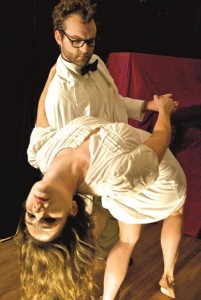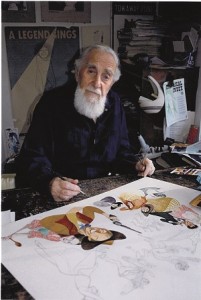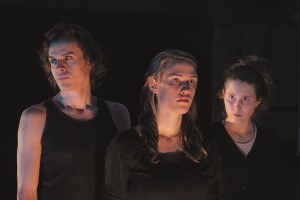State of the Teaching Art
PAWTUCKET, R.I.: When Steve Kidd, the education director of the Sandra Feinstein-Gamm Theatre, attended a presentation by Chicago-based cultural policy analyst Nick Rabkin, he learned a lot about the condition of teaching artists nationwide—and discovered there was a lot more to learn. “Rabkin did a study of teaching artists in 12 American cities, and it revealed how much we struggle financially, and how much we struggle outside school-based programs,” says Kidd.
Eager to know more about what could be done to help teaching artists with these challenges, Kidd went to the Rhode Island State Council for the Arts (RISCA) and lined up a $29,900 grant from the Rhode Island Foundation for the brand new Rhode Island Teaching Artists Center (RITAC), to be housed and administered at the Gamm, under the leadership of program director Arik Beatty.
“We just sent out a survey about a week ago aimed at teaching artists, and also members of the community interested in working with them,” says Beatty. At press time, he had some 58 responses, many from within the state; about 39 percent of them had been working as teaching artists for more than 21 years, and nearly half said it was their primary source of income. “It was surprising—that’s actually better than I thought it would be,” Beatty notes.
Once the survey results are in, Beatty adds, RITAC will be “able to structure and build what the rest of the year will look like,” and consider what resources make the most sense for teaching artists. Let the learning curve begin.
Bullish on Bullins
NEW YORK: Black theatre pioneer Ed Bullins, honored a few years ago with TCG’s Visionary Leadership Award, now has a theatrical season honoring him. Though Woodie King Jr.’s New Federal Theatre will mount just two of Bullins works—a staging of In the Wine Time (through Nov. 24 at the Castillo Theater), directed by Mansoor Najee-ullah, and a rare New York revival of The Fabulous Miss Marie in April 2014, also at the Castillo—the company is officially dedicating its season to Bullins, who began making theatre in New York in 1965 and who founded the New Lafayette Theatre in Harlem the following year.
King doesn’t mince words about the veteran scribe: “No other black playwright before had exerted a greater influence on contemporary black theatre.” Also in the New Federal Theatre season are two world premieres, Richard Abrons’s Every Day a Visitor, slated Nov. 1–Dec. 14 at the Clurman Theater, and Clare Coss’s Dr. DuBois and Miss Ovington, opening Jan. 30 at the Castillo, starring Kathleen Chalfant and Peter Jay Fernandez.

Price Drop
ALBUQUERQUE, N.M., and MILWAUKEE, WiSC.: Two theatres aren’t rethinking the concept of ticketing altogether, but they are changing the rules of price and availability. At the end of last season, Hannah Kauffman, co-artistic director of New Mexico’s Tricklock Theatre Company, says she had “a completely cockamamie idea that we should do away with ticket sales altogether.” Though the company didn’t make that leap, it decided to implement two new ideas. The first involved slashing ticket prices—$15 for general admission and $12 for students and seniors—which, according to Kauffman, is about half of what most professional theatres in the area charge for admission. “It’s extremely important to the company that we stick to a Ford model—if we couldn’t afford to pay it, we’re not asking patrons to pay it,” she says.
Tricklock also reserves a portion of tickets that are completely subsidized for nonprofit and lower-income communities. “A percentage of seats for each show are set aside for targeted community groups who have been invited or expressed interest after hearing about the program, and those seats are completely free of charge,” says Kauffman, adding that the subsidy is supported by a grant from the McCune Charitable Foundation, with additional funding from the U.S. New Mexico Federal Credit Union and patrons.
Meanwhile, Milwaukee’s First Stage is also experimenting with reduced-price tickets. Its “First Stage for Five” initiative offers 500 tickets throughout the season for a mere $5 a pop. The program is intended for families and individuals who might not otherwise be able to attend due to financial hardship. “We want to ensure that the unique, shared experience of attending a First Stage performance is accessible to as many families as possible,” says managing director Betsy Corry.
Tricklock’s Kauffman ponders the equation from both an artistic and administrative perspective. “In a city like Albuquerque, overflowing with quality theatre but extremely low on a cost-of-living scale, what kind of impact could subsidy have—not only on low-income communities who aren’t generally exposed to theatre, but on us low-income artists who are struggling to find the root of their artistic ambitions while handling their own administrations?” A question for the ages, that.
Destination Theatre
THE HIGH SEAS: Plays are often compared to journeys, but in the case of Oregon Shakespeare Festival’s “Shakespeare at Sea III,” this isn’t a metaphor. The cruise—an eight-stop jaunt starting and finishing in Athens, Greece, Nov. 10–20—will take 91 patrons on a tour to the origins of Western drama. Stops will include Ephesus, famous not only as an ancient Greek theatrical site but also as the setting of The Comedy of Errors; and Priene, Turkey, where company member Miriam Laube will offer a reading in the ruins of a 4th-century BCE theatre. Istanbul and Pergamon are also on the agenda, as are a crash course in theatre history by Lue Douthit, OSF’s director of literary development, and a glimpse of OSF’s 2014 season from executive director Cynthia Rider.
In addition to Laube’s reading, performances include Rex Young doing An Iliad; Young and Laube joining company members Emily Sophia Knapp and Mark Bedard for an evening of songs from OSF shows; and, perhaps most notably, a climactic reading of The Tempest with parts for everyone on board. The price tag ranges from $1,500 for a single cabin to nearly $10,000 for four in the Neptune Suite.
Line ’Em Up
NEW YORK: From a humble barber’s chair, he cut theatrical legends down to size—or down to a few sinuous lines, that is. Now that caricaturist Al Hirschfeld’s famous chair and drawing table sit in the New York Public Library for the Performing Arts, it only stands to reason that the performance portraiture he created starting in 1926 up until his death in 2003 is now on display through Jan. 4 in the library’s Oenslager Gallery.

The extensive new exhibit, titled “The Line King’s Library,” contains such rarities as a never-before-published 1969 portrait of Martha Graham; the original drawing of “Broadway First Nighters,” Hirschfeld’s mural for the Playbill Room at the Hotel Manhattan, installed 55 years ago; material from Sweet Bye and Bye, a musical he wrote with S.J. Perelman, Vernon Duke and Ogden Nash; and artworks he collected from colleagues, including a stash of shadow puppets. Says curator David Leopold, “Putting together this show has been a curator’s dream, as it is an embarrassment of riches. I always maintain that Hirschfeld was not the best at what he did—he was the only one who did what he did.”
Actually, following openly in Hirschfeld’s footsteps has been Ken Fallin, another pen-and-ink caricaturist who got his start parodying the master in 1980s-era ad campaigns for the revue Forbidden Broadway. Seventy-five of Fallin’s portraits of theatrical figures, as well as celebrities and politicians, are on display through Dec. 31 on the walls of New World Stages, a commercial Off-Broadway complex in New York’s theatre district. Ninas need not apply.
Diamond “Dream”
WEST PALM BEACH, FLA.: House-hunting doesn’t typically inspire a theatrical production. But for actor/director Trent D. Stephens of Lightbulb Factory Theatre, a visit to the Ann Norton Sculpture Gardens in West Palm Beach a few years ago not only led him to a new apartment (he lives in the estate’s guest house) but also to his next theatre piece: a bejeweled and bedazzled A Midsummer Night’s Dream. Stephens has adapted the Bard’s classic into a 60-minute environmental production in which onlookers stroll through the 1.7 acres of sculpture gardens with a glass of champagne in hand as the action unfolds around them.
Stephens’s day job as an event coordinator and office assistant for Diamante Atelier, a rare colored-diamond investment broker, supplied the production’s coup de grace: The actors will be sporting jewels lent by the broker—“everything from Cartier antiques to Elizabeth Taylor’s one-of-a-kind jewelry from House of Taylor,” says Stephens. And the jewels won’t just be for the ladies, Stephens points out: “I plan on getting some emeralds for Oberon, and of course Puck will have something special.”
Midsummer, which runs at the gardens Nov. 15–16, marks the Lightbulb Factory’s first full-fledged production. “Usually you start a company by selling candy bars and a car wash. With this we have a champagne and vodka sponsor,” boasts Stephens, who is cooking up plans for more jewelry-centered plays. His next idea: a radio play about a diamond heist in the spring. “We’ll do it live at the Breakers Hotel,” he says.

Three Black Cats
CLEVELAND and AKRON, OHIO: Cleveland’s Theater Ninjas are about to conclude a three-location site-specific tour of Obie-winner Erin Courtney’s play Black Cat Lost. Performances of Courtney’s poetic meditation on grief and impermanence began at Arts Collinwood, a film and music venue in East Cleveland, last month before moving to 78th Street Studios in West Cleveland, and finally Summit ArtSpace in Akron this month.
“78th Studios is actually a former American Greetings warehouse,” notes Ninjas artistic director Jeremy Paul, “whereas Summit ArtSpace has a lot of galleries that have a very raw, open-space feel.”
Paul says he was drawn to Courtney’s text—influenced by Zen poetry, silent-film imagery, fiction and memoir—because of its “fascinating shape. It weaves together so many different ideas, art forms and raw expression with rhythm and energy,” says Paul. The play, which is not structured in a typical narrative manner, is constantly moving; so, too, will the audience, even participating in various activities and games. “We’re planning to do something with sand, a material that’s very impermanent,” says Paul, adding that water is another element that may enter the equation.
Theatre Ninjas recently concluded a four-month partnership with the Cleveland Museum of Art that included an exhibition/installation called “The Excavation,” about the ruined city of Pompeii. The group, which was founded in 2006, is committed to reducing barriers to the avant-garde and providing opportunities for new artists and audiences to engage with each other..
East and West Players
BROOKLYN and ANAHEIM, CALIF.: It’s been a good fall for two companies on the East Coast that opened new venues, and for one in Southern California that announced a move designed to double its capacity.
Last month BRIC Arts | Media House opened the doors of a new $35-million, 40,000-square-foot multidisciplinary arts and media complex in a former theatre in the Fort Greene neighborhood of Brooklyn, which also houses the Brooklyn Academy of Music. Architect Thomas Leeser turned the former Strand Theatre building on Fulton Street into a complex featuring an art gallery and a television studio as well as a 240-to-400-seat flexible performance space and an artist’s work/performance studio. The space will kick off with a “Fireworks Residency,” bringing together designer/director Julian Crouch (Shockheaded Peter) with composer Mark Stewart and filmmaker Ragnar Friedank to create Armchair Parade, an installation featuring a 24-foot handmade musical instrument, original film and puppetry.
Right around the corner on Ashland Place, Theatre for a New Audience, which has done its Shakespeare-focused seasons at various Manhattan venues over the years, opens its first dedicated home venue this month with a new production of A Midsummer Night’s Dream directed by Julie Taymor, with music by her partner Elliot Goldenthal. Thanks to a $10-million gift in September from the Polonsky Foundation, TFANA’s new home, designed by Hugh Hardy, becomes the Polonsky Shakespeare Center, which includes a 299-seat mainstage, a 50-seat studio and a wraparound arts plaza.
Meanwhile, in sunny Orange County, the Chance Theater plans a move to a larger venue on the same block on La Palma Avenue in Anaheim where it’s resided since 1999, doubling its square footage and tripling its seating from 49 to 150. The move should happen by February of next year, with a further expansion of the Chance’s scenery workshop and offices by the end of 2014. The fundraising goal for the move and expansion is estimated at $700,000, of which roughly a third had been raised by press time.


